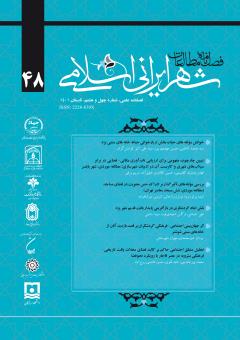تبیین چارچوب مفهومی برای ارزیابی تابآوری مکانی- فضایی در برابر سیلابهای شهری و کاربست آن در ادبیات شهرسازی؛ مطالعه موردی: شهر بابلسر
محورهای موضوعی : کاربست پایههای شهرسازی و معماری اسلامی در معماری معاصرالهام رضائیان کله بستی 1 , حسین کلانتری خلیل آباد 2 , مریم رزقی 3
1 - دانشجوی دوره دکتری شهرسازی، دانشگاه آزاد اسلامی واحد آیت الله آملی، آمل، ایران
2 - استاد جهاد دانشگاهی؛ دانشگاه آزاد اسلامی واحد آیت الله آملی، آمل، ایران
3 - مربی، گروه شهرسازی؛ دانشگاه آزاد اسلامی واحد آیت الله آملی، آمل، ایران
کلید واژه: سازمان فضایی شهر, آسیب¬پذیری, تاب¬آوری شهری, ابعاد مکانی- فضایی, سیلاب¬های شهری, بابلسر,
چکیده مقاله :
شاخص های سنجش تاب آوری مکانی- فضایی شهری، مستقیماً مربوط به ابعاد فیزیکی و زیست محیطی سیستم شهری بوده و در ارتباط با مؤلفه-های اصلی سازمان فضایی شهر قرار می گیرند. هدف پژوهش حاضر، ارزیابی تاب آوری مکانی- فضایی در برابر سیلاب های شهری در بابلسر است. این پژوهش به لحاظ روش، توصیفی-تحلیلی و به لحاظ هدف، کاربردی است. جمع آوری داده های پژوهش حاضر از طریق روش های کتابخانه ای و میدانی و ابزار گردآوری اطلاعات پرسشنامه بوده است. جامعه پژوهش حاضر متخصصان شهر بابلسر مرتبط با موضوع سیلاب های شهری بوده که از میان آنها 30 نفر به عنوان نمونه به صورت نمونه گیری احتمالی خوشه ای انتخاب شده اند. برای تحلیل داده ها از تحلیل های آماری میانگین، کلموگروف -اسمیرنوف، شاپیرو- ویلک و آزمون تی تک نمونه ای در نرم افزار SPSS و همچنین تکنیک AHP و WASPAS استفاده شده است. نتایج حاکی از آن است که شهر بابلسر به لحاظ تاب آوری در وضعیت نسبتاً مناسبی قرار دارد و لازم است که از پتانسیل ها و فرصت ها و منابع موجود در شهر در راستای بهبود تاب آوری مکانی–فضایی در برابر سیلاب به درستی استفاده کند.
Environmental problems related to urbanization have their roots in both ecological and urban development fields, led to the formation of joint research fields such as resilience. Urban spatial resilience indicators are directly related to physical and environmental dimensions and are related to the main components of the spatial organization of the city. The purpose is to explain the conceptual framework assessment against urban flooding in Babolsar and its application in urban planning, research method: descriptive-analytical, data collection method: library and field and tools. Data collection: questionnaire, statistical population: specialists of city related to the issue of urban flooding, of which 30 people were selected as a possible cluster sampling. Data analysis is done through mean, Kolmogrof-Smirnov, Shapiro-Wilk and t-test in SPSS software as well as AHP and WASPAS techniques. The results show that the city is in a relatively good condition in terms of resilience and it is necessary to use the existing potentials, opportunities and resources in order to improve spatial resilience against floods. The final status of the space organization has shown that the dispersion of uses, attention to natural elements and the condition of the road network and surrounding green and open spaces have been evaluated as favorable, and the lack of attention to the shape of the land, Attention to neighboring spots, lack of dispersion of high-risk spots, centralization of administration in the center of the city, centralization of functional elements by the river and centralization of services on the coastal strip are its negative points.
